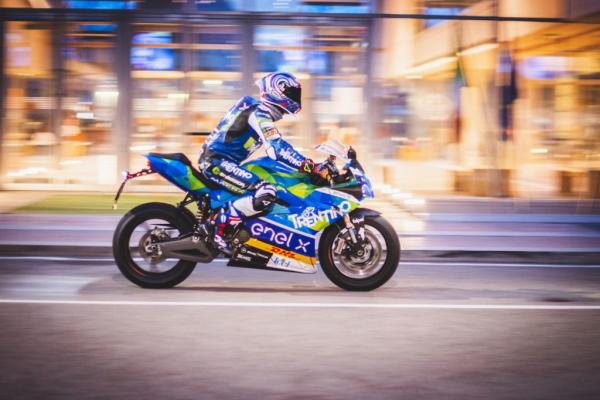
What is MotoE?
The future! We know the electrification of the motor industry is coming – in its entirety by 2030 onwards for many countries – and whilst this doesn’t have to mean motorsport goes entirely zero emissions in the future, it is reasonable to assume the Rossis and Marquezs of 2040 won’t be racing fossil-fuel powered machines.
Regardless, MotoGP won’t be making the leap overnight so MotoE is the first brick of that bridge to in essence trial the technology that will form the basis of the series’ bolder, greener future… only we get to enjoy it in racing format!
What is the MotoE bike?
A new ethos for MotoGP in that it will be using 18 identical machines derived from the road-going Energica Ego, which whilst slightly at odds with the series’ prototype ethos is referred to openly by Dorna as a ‘parallel path’.
In laymen’s terms, the focus on getting the technology both optimised and reliable means using the Energica Ego levels the playing field to push back the onus on team set-up and rider ability.
That isn’t to say it will always be like this and it is anticipated that once teams get their head around the technologies will open the regulations to allow unique drivetrains and possibly even frames.
With Formula E brimming with manufacturer entries now only four years on, MotoE could become the path into MotoGP for currently unrepresented brands like BMW, Kawasaki and Triumph…
How fast is a MotoE bike?
The uprated ‘race-spec’ Ego Corsa, with its specification Michelin tyres, is expected to reach a top speed of 168mph and a 0-60mph time of 2.8secs, though with no restrictions this is said to reach 175mph.
The motor produces 120kW continuous power and 200Nm of torque from a 20kWh lithium ion battery
We’re particularly excited to see the start where the linear acceleration is likely to make the sprint down to turn one a particularly exciting sight, while we’re curious as to how such uninterrupted torque affects slipstreaming…
Who will be competing?
A VERY diverse mix of riders across the age, experience, nationality and gender spectrum!
Ex-premier class stalwarts like Sete Gibernau, Randy de Puniet and Alex de Angelis go up against recent MotoGP converts like Bradley Smith and Xavier Simeon, plus a smattering of Superbike/Supersport refugees as Niccolo Canepa, Lorenzo Savadori and Niki Tuuli, while fast female racer Maria Herrera is also set to court attention.
Interestingly though, in the recent test and practice ‘race’ it was the younger portion of the field – like Eric Granado and Hector Garzo – that came out top.
There is plenty of establishment on the teams’ side, with most MotoGP satellite teams present with Pramac, Avintia, LCR, One Energy (Petronas SRT), Tech 3 and Gresini, plus former entrants Angel Nieto (Aspar) and Marc VDS. The line-up is completed by established Moto2/3 teams Ajo, Intact GP, Ongetta and Pons
Where will MotoE be racing?
We should be almost halfway through the season by now but the devastating paddock fire that destroyed all 18 bikes back in February forced the opener to be rescheduled for this weekend’s German event at the Sachsenring.
From here, it will move on to Red Bull Ring for the Austrian MotoGP, before Round 3 and Round 4 take place at a Misano double-header. The season rounds off with another double-header in Valencia, each in support of MotoGP.
MotoE will get two Friday practice sessions (30mins) and the grid will be decided by an E-Pole session on Saturday’s, played out over a single lap shootout against the clock.
How long are the MotoE races?
It is no coincidence Moto-E will take place at some of the shorter venues on the calendar (the others pre-fire being Jerez and Le Mans) as the top speed and full throttle limitations won’t optimise the package as much as they would somewhere like Aragon or Mugello – for now.
This can also be explained in part by the desire to steer the series away from the ‘energy-saving’ element adopted as part of the ‘racing challenge’ in Formula E.
As such, this weekend’s German Moto-E race will be held over 8 laps, a short but full throttle sprint to the line… think of it as potentially the final laps of a Moto3 race but from start-to-finish!
What to look out for…
Electric motorsport isn’t ‘new’ as Formula E has been street racing since 2014, but Moto-E is the first to be fully absorbed into a major race weekend schedule and played out over international FIM-accredited circuits. This is a pretty huge fact and whilst it means it now has a purist fanbase to win over from day one – not easy feat – it is also a huge stage to potentially sway the cynics.
Whilst comments about ‘noise’ are never too far away and the idea of an amplifier of sorts has been raised, the decision to keep the sound – as mutedly whirring as it is – is a chance to get a different audible sensation from squealing tyres to match what you see as riders squirrel under brakes. Whether it works remains to be seen, but MotoE is different for a reason.
What does MotoE mean for motorbike racing?
MotoE is the first chapter in a new era that many assume will ultimately form the blueprint of MotoGP’s future, to a point where we won’t ‘need’ a MotoE series.
When that happens is anyone’s guess, but technology advances in this area can already be measured in marathons rather than steps so while short races, speed limitations and the lack of a pure sound are going to be a little alien right now, it won’t always be like this.
Tune into MotoE at the Sachsenring this weekend, it could be history in the making.

